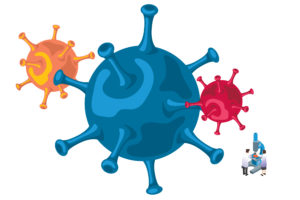If Ted Ross can pull off his plan to make flu season a thing of the past, he’ll become something of a scientific superhero.
But if you’d told an 18-year-old Ross that one day he’d be leading the charge to make a universal flu vaccine, he probably would’ve said, “Assuming I make it through calculus first.”
Growing up, Ross’s parents had instilled in him that education was the path to a good job and meaningful career. Grades were important. And he wasn’t making the kind of grade he would’ve liked in that advanced math class.
“I was making A’s in biology but not in calculus. That’s how I decided I was going to be a biologist,” Ross says with a chuckle.
He figured out what he was good at early on and stuck to it. Now, some 30 years after earning that bachelor’s in zoology (which he chased with a master’s and doctorate), Ross is on the road to making scientific history.
His journey to securing the largest grant ever received by the University of Georgia started with a puzzle: How do we develop a flu vaccine that works against multiple strains of the virus but doesn’t have to be given every year? Ross’s $130 million contract with the National Institutes of Health (NIH) is helping him put the pieces in place.
The grant, which could last up to seven years, established sites across the country with three distinct missions: one group designs, develops, and evaluates potential vaccines; another manufactures and tests the vaccines; and the others are in charge of conducting the Phase I and Phase II clinical trials.
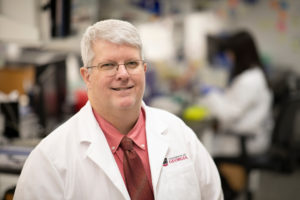
“Designing a vaccine that works against every single flu strain now and in the future is a really high-bar challenge.” — Ted Ross, Georgia Research Alliance Eminent Scholar of Infectious Diseases
These Collaborative Influenza Vaccine Innovation Centers, or CIVICs, bring together 200 scientists from over 100 universities and research institutions around the world in a coordinated, multidisciplinary effort to develop universal flu vaccines.
Housed in UGA’s College of Veterinary Medicine, Ross’ lab is one of the design sites. His team draws from more than a dozen international institutions and from UGA’s own vaccine center, Department of Infectious Diseases, and College of Public Health.
Calling the project a massive undertaking would be an understatement. But it’s one the world desperately needs one, and Ross is committed to seeing through to the end.
Why Flu?
There’s a very common misconception about flu that Ross wants to squash.
“People say, ‘Oh, I got a little touch of the flu.’ That’s not true,” says Ross, the Georgia Research Alliance Eminent Scholar of Infectious Diseases. “If you get influenza, you will be in bed and feel very sick and ill and nauseated.”
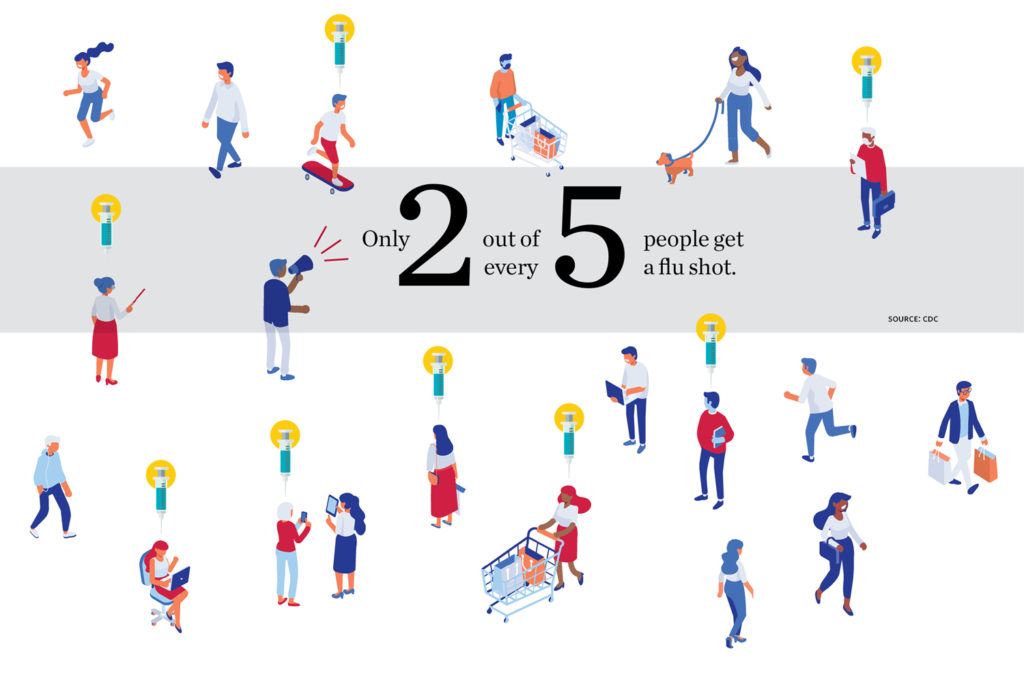 Ross would know. He had a run in with the flu when he was getting his doctorate. He was working in his lab at Vanderbilt when he suddenly felt so ill that he needed to go home. Problem was, he had walked to work. He made it as far as the university’s medical center before realizing he wasn’t going to make it home. He went directly to the ER.
Ross would know. He had a run in with the flu when he was getting his doctorate. He was working in his lab at Vanderbilt when he suddenly felt so ill that he needed to go home. Problem was, he had walked to work. He made it as far as the university’s medical center before realizing he wasn’t going to make it home. He went directly to the ER.
Flu has become so ubiquitous in modern day life that people forget how dangerous it can be. Every year in the U.S., the virus kills tens of thousands, making it a bigger cause of death than car accidents. Worldwide, that number climbs to more than a quarter of a million. Hundreds of thousands more are hospitalized like Ross was.
Those hospitalizations translate into huge economic loss. The NIH estimates that flu costs the average community across the country around $2.47 million annually. That adds up to billions of dollars lost in productivity due to a virus that could be prevented with a better shot.
But the flu virus’ ability to constantly evolve and develop new and more virulent strains makes it difficult to fight.
It’s also the reason why annual flu shots only reduce your risk of getting the flu in a given year by 40% to 60%, which might explain why only about two out of every five people get a flu shot, according to the CDC.
“For measles, mumps, rubella, there’s really only one version of the virus; others like polio, there are just a couple of versions,” Ross says. “Designing a vaccine that works against every single flu strain now and in the future is a really high-bar challenge.”
But it’s one Ross and his colleagues are eager to tackle.
His lab will use a complex algorithm to analyze the different varieties of a given type of flu to determine the common characteristics among its different strains. Then, they’ll create a molecule with those characteristics that can be put into vaccines. Like a traditional shot, the molecule will help the body’s immune system recognize and attack the flu virus, no matter which strain caused the infection.
UGA researchers will focus specifically on how a new vaccine can better protect particularly vulnerable populations—like children, the elderly, and those with weakened immune systems—who are more likely to be hospitalized or die from the virus.
Getting There
As fascinating as he finds flu now, Ross didn’t start his career thinking he would be battling one of the most common viruses on Earth. “Most of my friends were planning to go to med school and become doctors. If you talk to someone in biology, 90% of them are ‘going to go to med school.’”
But Ross didn’t want to be a doctor—at least not that kind of doctor.
He had been fascinated by science ever since he watched the moon landing as a kid. When he got to college at the University of Arkansas, he took a gig as a lab tech working on fetal alcohol syndrome and its effect on brain tissue.
That led to working on human T-cell leukemia virus, a cousin of HIV, as a grad student. Ross continued to work on HIV after earning his doctorate and taking a position at the Emory Vaccine Center in Atlanta. But soon his attention was drawn to another deadly virus: flu.
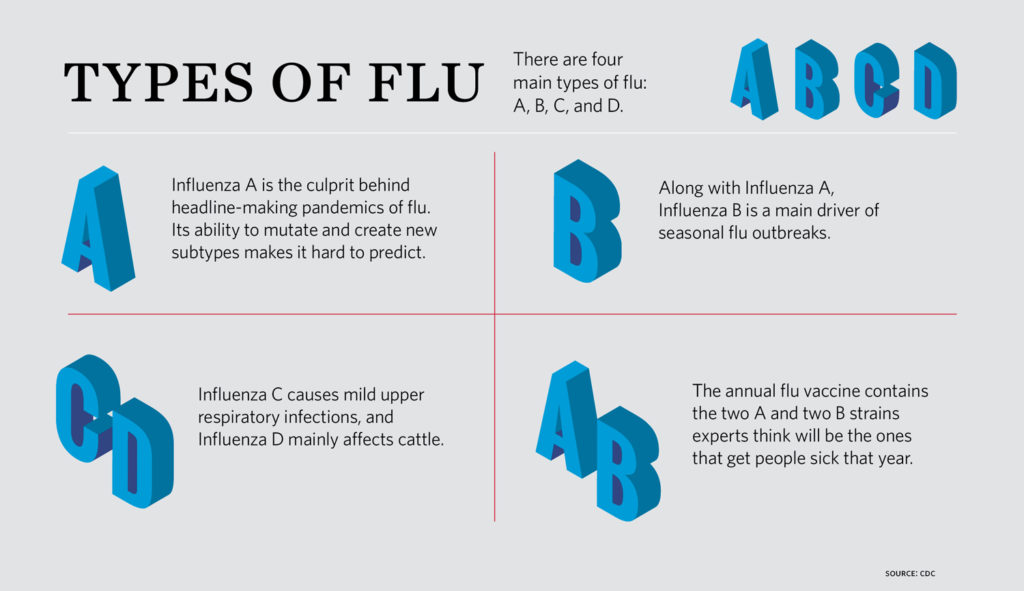 It was the end of the 1990s, and Hong Kong had a flu outbreak unlike any seen in years. The virus killed three out of every four people it infected, a rate that nearly echoed the 1918 Spanish flu pandemic that killed at least 50 million people worldwide and infected one out of every three. The CDC was overwhelmed and worried the world was facing another catastrophic pandemic. The organization asked Emory researchers to pick up the slack in the lab while they handled the public health side.
It was the end of the 1990s, and Hong Kong had a flu outbreak unlike any seen in years. The virus killed three out of every four people it infected, a rate that nearly echoed the 1918 Spanish flu pandemic that killed at least 50 million people worldwide and infected one out of every three. The CDC was overwhelmed and worried the world was facing another catastrophic pandemic. The organization asked Emory researchers to pick up the slack in the lab while they handled the public health side.
Ross was one of those researchers, and over the next decade his lab would shift from primarily focusing on HIV to flu. “I got into influenza sort of through the back door,” he says.
When Ross was at the University of Pittsburgh, a conversation he had with a grad student set off a chain of events that would ultimately lead to the CIVIC grant.
“We realized one of the problems we had with flu at that time was that we didn’t have a lot of information about new emerging strains that were circulating,” Ross says. Whenever a new outbreak occurred, scientists flocked to the site, getting samples of the virus and uploading them into public databases. It flooded the databases with information on those massive outbreaks but didn’t account for the variety of other flu strains circulating throughout the rest of the world at the same time.
So, they created COBRA, a computer program that synthesized the different subtypes of a particular strain of pandemic flu. It caught the attention of a pharmaceutical company. Could the researchers use COBRA for run-of-the-mill, seasonal flu? “We said, ‘Sure. If you give us the money, we can do that.’”
Now, about a decade after that research-altering conversation, Ross is poised to make flu research history.
Despite being the face for flu research at UGA, Ross isn’t doing it alone.
Four other researchers working on the CIVIC project are the College of Pharmacy’s Eva Strauch and the College of Public Health’s Andreas Handel, Ye Shen, and Justin Bahl (who has a joint appointment with the Department of Infectious Diseases in the College of Veterinary Medicine). All of Ross’s colleagues and lab staff in the Center for Vaccines and Immunology play a pivotal role in the process as well.
Mark Tompkins, a virologist, immunologist, and professor of infectious diseases, is determining how the virus infects people and how vaccines can be effective at blocking that from happening. Jarrod Mousa, an assistant professor of infectious diseases, investigates how antibodies bind to the flu virus and how a vaccine can prevent that from happening. And Karen Norris, GRA Eminent Scholar in Immunology and Translational Biomedicine, is a renowned animal model expert who tests the vaccine candidates, a key step needed before the shots can move on to clinical trials.
The collaborative atmosphere is one reason UGA became a CIVIC site.
“Certainly, there are programs where you have a researcher in a silo doing their work, and they can have a very productive career,” says Tompkins. “But when you look at groups that have regular afternoon teas where they just get together and talk, those interactions can synergize into really unexpected new ideas as well as really strong collaborative, synergistic programs. And that increases the trajectory of the research.”
And all the researchers are quick to point to their lab crew—undergrads, graduate students, postdocs, and research professionals—as the workhorse of the entire operation, as well as their reason for being at UGA.
The students and lab staff have been valuable assets in getting the universal vaccine research to this point and will continue to be as the research moves forward.
As for Ross, after 15 years of working on flu, he’s finally at what he calls the halfway point. The next steps will involve determining which vaccine candidates are the most promising and getting them into Phase I and then Phase II trials. “Flu is probably what I will be doing for the rest of my career,” says Ross.
But he wouldn’t have it any other way.
The Center
The Center for Vaccines and Immunology was established in 2015, with Ted Ross serving as the founding director. Housed in the College of Veterinary Medicine, the center’s faculty focus on the immunology of infectious diseases and how vaccines work in different populations based upon age, gender, and ethnicity. It also serves as a training ground for the next generation of researchers, relying on both undergraduate and graduate students in addition to post-doctoral research associates.
The center added two more faculty, Chester Joyner and Anne S. De Groot, during spring 2020, in addition to assistant research scientists Anne Bebin-Blackwell and Giuseppe Sautto, who came aboard in fall 2019. The center will eventually include a total of 150 staff scientists, post-docs, and students.
Karen Norris, GRA Eminent Scholar in Immunology and Translational Biomedicine
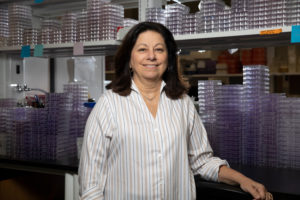 Karen Norris is a renowned expert in translational medicine and developing high-level models that help move treatments and vaccines from the lab into clinical trials. Her lab focuses on infections associated with people who have compromised immune systems, pregnant women,
Karen Norris is a renowned expert in translational medicine and developing high-level models that help move treatments and vaccines from the lab into clinical trials. Her lab focuses on infections associated with people who have compromised immune systems, pregnant women,
infants, and the elderly. Norris’s team has established models for Pneumocystis pneumonia, an illness that sometimes develops in patients with HIV/AIDS; respiratory syncytial virus, or RSV; cardiopulmonary diseases, like COPD (chronic obstructive pulmonary disease); and diabetes.
Mark Tompkins, Professor
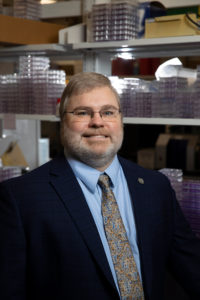 Mark Tompkins is the only center faculty member recruited from within UGA. His research focuses mostly on human and zoonotic influenza, which crosses the barrier from animals to infect people, like bird or swine flu. As part of the Emory-UGA Center of Excellence for Influenza Research and Surveillance, which is funded by the National Institute for Allergy and Infectious Diseases, Tompkins’s goal is to determine how a flu virus will mutate across animal and then human populations through explorations of the virus at the cellular and host levels. His lab then finds ways to exploit these interactions to develop vaccines, antiviral drugs, and treatments for human and animal use.
Mark Tompkins is the only center faculty member recruited from within UGA. His research focuses mostly on human and zoonotic influenza, which crosses the barrier from animals to infect people, like bird or swine flu. As part of the Emory-UGA Center of Excellence for Influenza Research and Surveillance, which is funded by the National Institute for Allergy and Infectious Diseases, Tompkins’s goal is to determine how a flu virus will mutate across animal and then human populations through explorations of the virus at the cellular and host levels. His lab then finds ways to exploit these interactions to develop vaccines, antiviral drugs, and treatments for human and animal use.
Jarrod Mousa, Assistant Professor
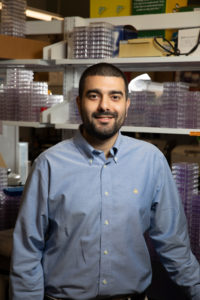 Jarrod Mousa’s lab concentrates on the immune system and the antibodies your body uses to fight infection. Viruses, bacteria, parasites, and fungi have surface-level proteins that attach themselves to host cells. The goal for the Mousa lab is to harness the immune system to work more effectively by determining where antibodies bind on virus molecules and which spots are the most effective at knocking out the virus. The answers the lab finds are the basis of future vaccines and therapeutics.
Jarrod Mousa’s lab concentrates on the immune system and the antibodies your body uses to fight infection. Viruses, bacteria, parasites, and fungi have surface-level proteins that attach themselves to host cells. The goal for the Mousa lab is to harness the immune system to work more effectively by determining where antibodies bind on virus molecules and which spots are the most effective at knocking out the virus. The answers the lab finds are the basis of future vaccines and therapeutics.
Chester Joyner, Assistant Professor
Coming onboard in January 2020, Chet Joyner’s work focuses on a major cause of malaria: Plasmodium vivax. The parasite remains a major obstacle for public health officials in their battle to control and eliminate malaria because it can remain dormant in the liver, causing no real symptoms of the disease until the parasite reactivates.
Anne S. De Groot, Senior Research Professor
A practicing physician, immunologist, and co-founder and CEO of the pharmaceutical company EpiVax, Annie S. De Groot is a board-certified internal medicine and infectious diseases physician. While at Brown University, De Groot worked at the intersection of immunology, bioinformatics, and genomics to find ways to make vaccines more efficient and more effective, founding EpiVax, which develops commercial-grade tools used by the largest pharmaceutical companies, in 1998. She later became the director for the University of Rhode Island’s Institute for Immunology and Informatics before arriving at UGA in 2020.



